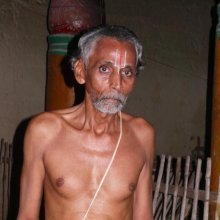Curd: 2 definitions
Introduction:
Curd means something in Hinduism, Sanskrit. If you want to know the exact meaning, history, etymology or English translation of this term then check out the descriptions on this page. Add your comment or reference to a book if you want to contribute to this summary article.
Images (photo gallery)
In Hinduism
Ayurveda (science of life)
Veterinary Medicine (The study and treatment of Animals)
Source: Asian Agri-History: Paśu Āyurvēda (Veterinary Medicine) in GaruḍapurāṇaCurd (in Sanskrit: dadhi) is used in the Viśodhana (“washing off the wound’s impurities”) of wounds (vraṇa), according to Āyurveda sections in the Garuḍapurāṇa.—[...] After Viśodhana (wash off the ulcer's/wound's impurities by medicated decoction), the following formulations can be used for śodhana (purification) and ropaṇa (healing) externally:—[... e.g.,] The tila (gingelly), saktukapiṇḍikā (fried grain flour), saindhava (rock salt) and nimbapatra (neem leaves) are ground well with dadhi (curds). [...]
Agriculture (Krishi) and Vrikshayurveda (study of Plant life)
Source: Shodhganga: Drumavichitrikarnam—Plant mutagenesis in ancient IndiaCurd (denoted by the Sanskrit term Dadhi) is used in certain bio-organical recipes for plant mutagenesis, such as changing a plant into a creeper, according to the Vṛkṣāyurveda by Sūrapāla (1000 CE): an encyclopedic work dealing with the study of trees and the principles of ancient Indian agriculture.—Accordingly, “A seed of any variety freely rubbed with the bark of Mangifera indica creeper, Jasminum grandiflorum, Woodfordia fruticosa and Hiptage benghalensis mixed with the milk of a she-goat and then sown in a pit, filled with soil dug up from around the roots of trees belonging to different species and thereafter sufficiently sprinkled with the powder of sesame and barley and (the seed so sown) watered with curd (dadhi) and milk grows into the respective creeper”.

Āyurveda (आयुर्वेद, ayurveda) is a branch of Indian science dealing with medicine, herbalism, taxology, anatomy, surgery, alchemy and related topics. Traditional practice of Āyurveda in ancient India dates back to at least the first millenium BC. Literature is commonly written in Sanskrit using various poetic metres.
See also (Relevant definitions)
Starts with: Curd-wort.
Full-text (+686): Dadhi, Pancagavya, Rasala, Amiksha, Shrighana, Pancamrita, Mastu, Dadhyodana, Madhuparka, Prishadajya, Payasya, Kilata, Drapsa, Phani, Navanita, Tarunadadhi, Dadhyuda, Dahihandi, Dadhyanna, Takra.
Relevant text
Search found 178 books and stories containing Curd; (plurals include: Curds). You can also click to the full overview containing English textual excerpts. Below are direct links for the most relevant articles:
Charaka Samhita (English translation) (by Shree Gulabkunverba Ayurvedic Society)
Chapter 27i - The section on Cow’s milk (Gorasa) < [Sutrasthana (Sutra Sthana) — General Principles]
Chapter 13 - Oleation Therapy (Sneha) < [Sutrasthana (Sutra Sthana) — General Principles]
Chapter 20 - The therapeutics of Vomiting (chardi-cikitsa) < [Cikitsasthana (Cikitsa Sthana) — Section on Therapeutics]
Atithi or Guest Reception (study) (by Sarika. P.)
Part 1 - Introduction to Madhuparka (ceremonial reception) < [Chapter 8 - Madhuparka]
Part 2 - References to Hospitality in the Kumārasaṃbhava < [Chapter 4 - Atithi-saparyā in Classical Sanskrit Literature]
Manusmriti with the Commentary of Medhatithi (by Ganganatha Jha)
Verse 5.10 < [Section II - Objectionable Food]
Verse 10.88 < [Section IX - Variations in the Functions of the Brāhmaṇa due to Abnormal Conditions]
Verse 5.113 < [Section XIII - Purification of Substances]
Trishashti Shalaka Purusha Caritra (by Helen M. Johnson)
Part 1: Conclusion of Udāyana-story < [Chapter XII - Omniscience and wandering of Mahāvīra]
Part 12: Story of the two bulls < [Chapter III - Mahāvīra’s first six years as an ascetic]
Part 3: Dhanya < [Chapter X - Stories of Daśārnabhadra, Śālibhadra and Dhanyaka]
Rig Veda (translation and commentary) (by H. H. Wilson)
Amarakoshodghatana of Kshirasvamin (study) (by A. Yamuna Devi)
Daily Life (1): Food and Drinks < [Chapter 3 - Social Aspects]
Vedic Sacrifices < [Chapter 4 - Cultural Aspects]
Related products
(+60 more products available)








